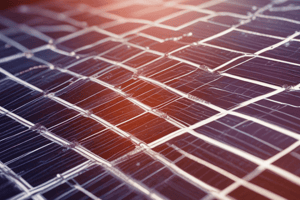Podcast
Questions and Answers
What is the anode reaction during discharge of a lead-acid battery?
What is the anode reaction during discharge of a lead-acid battery?
- PbSO4(s) + 2H+ (aq) + 2e → Pb(s) + H2SO4 (aq)
- PbO2 (s) + H2SO4 (aq) + 2H+ (aq) + 2e → PbSO4 (s) + 2H2O (l)
- 2H2O (l) → 2H2 (g) + O2 (g)
- Pb (s) + H2SO4 (aq) → PbSO4 (s) + 2H+ (aq) + 2e (correct)
What is the cathode reaction during discharge of a lead-acid battery?
What is the cathode reaction during discharge of a lead-acid battery?
- PbSO4(s) + 2H+ (aq) + 2e → Pb(s) + H2SO4 (aq)
- H2 (g) + O2 (g) → 2H2O (l)
- PbO2 (s) + H2SO4 (aq) + 2H+ (aq) + 2e → PbSO4 (s) + 2H2O (l) (correct)
- Pb (s) + H2SO4 (aq) → PbSO4 (s) + 2H+ (aq) + 2e
What is the net reaction during discharge of a lead-acid battery?
What is the net reaction during discharge of a lead-acid battery?
- H2 (g) + O2 (g) → 2H2O (l)
- 2PbSO4 (s) + 2H2O (l) → Pb (s) + PbO2 (s) + 2H2SO4 (aq)
- Pb (s) + PbO2 (s) + 2H2SO4 (aq) → 2PbSO4 (s) + 2H2O (l) + energy (correct)
- Pb (s) + H2SO4 (aq) → PbSO4 (s) + 2H+ (aq) + 2e
During charging, what is the anode reaction?
During charging, what is the anode reaction?
During charging, what is the cathode reaction?
During charging, what is the cathode reaction?
What is the net reaction during charging of a lead-acid battery?
What is the net reaction during charging of a lead-acid battery?
What is a characteristic of a lead-acid battery?
What is a characteristic of a lead-acid battery?
What is an application of lead-acid batteries?
What is an application of lead-acid batteries?
What is a characteristic of a fuel cell?
What is a characteristic of a fuel cell?
What is the principle behind a fuel cell?
What is the principle behind a fuel cell?
Flashcards are hidden until you start studying
Study Notes
Photovoltaic Cells
- Solar rays falling on p-type semiconductor promote electrons to conduction band, creating a potential difference and electric current
- Potential difference and current increase with more solar rays
- Connecting p- and n-layers to an external circuit allows electrons to flow from n-layer to p-layer, generating current
Photovoltaic Cell Set-up
- A photovoltaic module consists of multiple solar cells electrically connected and mounted in a single support structure
- Modules supply electricity at a certain voltage, such as 12-volt systems
- Current produced is directly dependent on light intensity reaching the module
- Multiple modules can be wired together to form an array
- Photovoltaic modules and arrays produce direct-current electricity
Photovoltaic Systems
- There are two main types of photovoltaic systems: grid-connected (on-grid) and autonomous (off-grid)
- Grid-connected systems inject electricity into the grid, requiring conversion of direct current to alternating current
- Autonomous systems operate independently of the grid
- Over 90% of photovoltaic systems worldwide are grid-connected
Solar Cells
- Solar cells are made of semiconductor materials, such as silicon
- One property of semiconductors is that their conductivity can be modified by introducing impurities into the crystal lattice
- There are several types of solar cells, with over 90% consisting of wafer-based silicon cells
- Wafer-based silicon cells are approximately 200 μm thick
- Thin-film solar cells are another type, approximately 1-2 μm thick and requiring less active material
Principle of Solar Cells
- The basic principle involves the photovoltaic effect, where sun rays falling on two layers of semiconductor devices create a potential difference
- This potential difference causes a flow of electrons, producing electricity
Construction of Solar Cells
- Solar cells consist of a p-type and n-type semiconductor in close contact
- The p-type is typically silicon doped with boron, and the n-type is silicon doped with phosphorous
Applications of Lead Storage Batteries
- Used in cars, motor cycles, and lorries to start engines
- Used in invertors for electric supply in telephone exchanges, railway trains, hospitals, automobiles, power-stations, and houses
Advantages of Lead Storage Batteries
- Relatively constant potential of 12V
- Portable and inexpensive
- Acts as a voltaic cell when drawing electricity and as an electrolytic cell when being recharged
Studying That Suits You
Use AI to generate personalized quizzes and flashcards to suit your learning preferences.





